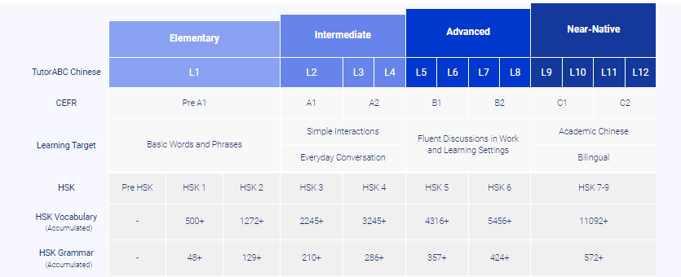There is a significant transition from the previous HSK 2.0 to the updated HSK 3.0. This transition is not merely a shift in the examination framework but embodies a more comprehensive approach to evaluating Chinese language proficiency. Here we delve into the key differences between HSK 2.0 and HSK 3.0, shedding light on what these changes entail for learners.
Vocabulary Expansion:
One of the most notable differences is the expansion of vocabulary across levels 1 to 6. Under HSK 3.0, learners are introduced to an additional 6092 words compared to HSK 2.0. This expansion implies a more robust language acquisition, preparing students for real-world interactions in a Chinese-speaking environment.
| |
HSK 2.
|
HSK 3.0
|
|
Lv
|
Vocabulary
|
Chinese Characters
|
Accum.*
|
Words
|
Accum.
|
Grammar Points
|
Accum.*
|
|
1
|
150
|
300
|
300
|
500
|
500
|
48
|
48
|
|
2
|
300
|
300
|
600
|
772
|
1272
|
81
|
129
|
|
3
|
600
|
300
|
900
|
973
|
2245
|
81
|
210
|
|
4
|
1200
|
300
|
1200
|
1000
|
3245
|
76
|
286
|
|
5
|
2500
|
300
|
1500
|
1071
|
4316
|
71
|
357
|
|
6
|
5000
|
300
|
1800
|
1140
|
5456
|
67
|
424
|
| 7-9 |
-- |
1200
|
3000
|
5636
|
11092
|
148
|
572
|
Introduction to Characters and Translation:
HSK 3.0 now includes a focus on handwritten Chinese characters and translation, aspects that were not emphasized in HSK 2.0. This not only enhances a student's ability to communicate effectively but also bridges the gap between digital and traditional forms of language usage.
Redistribution of Words:
Certain words that were previously introduced in higher levels of HSK 2.0 have now been redistributed to lower levels in HSK 3.0. For instance, the word "爱好" (hobby) which was at level 3 in HSK 2.0, is now introduced at level 1 in HSK 3.0. Similarly, "包子" (steamed bun) has moved from level 4 to level 1, indicating a shift towards a more practical and daily usage vocabulary from the outset.
Enhanced Learning Materials:
The transition from HSK 2.0 to HSK 3.0 is a substantial stride towards making Chinese language learning more comprehensive, practical, and aligned with real-world communication needs. The expanded vocabulary, introduction of handwritten characters and translation, and the redistribution of words across levels are indicative of a more holistic approach to mastering the Chinese language.

TutorABC Chinese has aligned its HSK course materials with the HSK 3.0 standards, ensuring that students are well-prepared and capable of excelling in the examinations under this new framework. TutorABC Chinese has compiled a vocabulary comparison table for Level 1 between HSK 2.0 and HSK 3.0. Please contact our education advisor to schedule and attend a demo class to receive the comparison table.